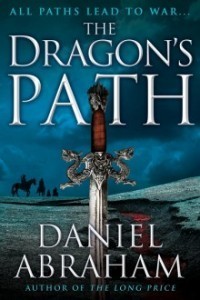Helen Lowe's Blog, page 287
August 26, 2011
Just Arrived: "The Broken Kingdoms" & "The Dragon's Path"
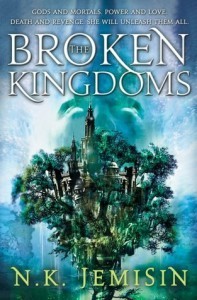 Although I'm very busy with the copyedit of The Gathering of the Lost at present, I still have to clear my mailbox—and today's post brought me two new books for the 'To Be Read' table:
Although I'm very busy with the copyedit of The Gathering of the Lost at present, I still have to clear my mailbox—and today's post brought me two new books for the 'To Be Read' table:
The Broken Kingdoms, the second in NK Jemisin's "Inheritance" trilogy, and
The Dragon's Path, the first in an epic Fantasy saga by Daniel Abraham.
Great covers on both of them and as I have enjoyed books by both authors before I am looking forward to the opportunity to read them—when time allows, of course!
To read my report back on NK Jemisin's first novel, The Hundred Thousand Kingdoms, click here.
My report on Daniel Abraham's A Shadow in Summer is here, and A Betrayal in Winter is here.
August 25, 2011
"Completed To Date"—aka It's Copyedit Time!
On Saturday August 20 I revealed that I was already in copyedit mode for The Gathering of the Lost, The Wall of Night Series Book Two, with a preferred deadline from my publisher of 31 August—generating the great 'will she/won't she' question of whether I would be able to make that or not!
I have been very gratified by the vote of confidence in your comments and hope that I can live up to them.:) So where have I got to with that countdown?
Target pages per day to finish by August 31: 76
Pages completed to date: 273
Pages until Completion (including glossary): 544
It's looking a tad touch and go for the 31st at present, but 'you never know'—let's see what the next few days bring …
(And don't forget you can show support in the traditional fashion–with a "toot."  )
)
August 24, 2011
"Fun With Thornspell": Week 4
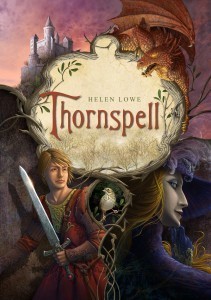 We're into the fourth—and penultimate, great word!—week of "Fun with Thornspell", which is this month's feature on the blog! And I've really been enjoying the comments coming in, all of which have great short story potential.
We're into the fourth—and penultimate, great word!—week of "Fun with Thornspell", which is this month's feature on the blog! And I've really been enjoying the comments coming in, all of which have great short story potential.
It's as Ursula Le Guin says in her book Steering the Craft (although I am paraphrasing rather than direct quoting)—the ideas are always there, you just have to be willing to reach into the creative air and grasp them! (And as Le Guin has been doing just that—quite wonderfully—for a lifetime now, I for one am very willing to listen to what she has to say.  )
)
OK, back to "Fun With Thornspell!" Your part of the deal is that you comment and let me know which Thornspell character you would like a story written about—and why that character, in particular.
My part of the deal is that each week I post a bit about another aspect of writing Thornspell, which you may or may not have heard about before. So here's my part for this week:
About Thornspell: Auld Hazel
Several commenters have indicated that Auld Hazel, the witch of the wood, is their preferred character for a Thornspell short story. And Nancy Siscoe, Thornspell's editor at Knopf, said that it was when Sigismund first met Auld Hazel that she began to fall in love in with the story.
Needless to say, the character of Auld Hazel comes primarily from the realm of imagination, but as always there are a few elements where the realms of the real, and that of imagination, overlap. But to begin, I think we should take a look at that first meeting between the young Sigismund and Auld Hazel …
.
.~ from Chapter 1, The Silent Wood
…
"The old western gate into the castle was long since walled up, but there was still the remains of a road that must have run into the forest once. It was little more than two rutted and stony wheel tracks now, but Sigismund had followed it one day, making his escape from the castle by means of a mossy channel that had once been the moat, and a culvert under the outer wall. The road did not go far, petering out into a bridle path within a few hundred yards of the castle wall, and fading away altogether beneath the forest eave.
It had been very dark and quiet beneath the canopy: a heavy, listening silence. There was no call of bird or insect, no whisper of a falling leaf – not even the wind stirred. Sigismund had felt the fine hairs lifting along his forearms and up the back of his neck, and taken a step back.
"Wise boy." The voice that spoke was dry as one leaf skeleton settling on another. Sigismund had whipped around, but saw nothing until there was a stirring between two, downbent hazel trees and a crone hobbled out. She must have been gathering firewood along the forest fringe, for there was a load of bundled sticks on her back and she had to twist her head to look at him. Her eyes were sharp and bright as a blackbird's, but sunk into the weathered seams of her face. Sigismund had thought she looked a little like an old tree herself, knotted and twisted with the years, although she moved more like the blackbird, coming close to him with a light, hopping step.
She was lame, he saw then, that was why she hopped. He stared, half shocked, half delighted, when he saw that she was puffing on a small, flat bowled pipe. A thread of smoke rose from it, curling into a question mark above the glow of orange embers.
"That load's too heavy for you, Granny," he said. "Let me carry it back to the castle, and the stable master will find a donkey to take you both down to the village."
Light and shadow flickered across the seamed face like sun through shifting leaves, and her laugh was a cackle, dry as her first words. "Ye've a kind heart, lad," she said, "for all yer lordly clothes, but don't 'ee worrit about auld 'azel. I'm used to burdens, born to 'em, 'ee might say." She chewed on the pipe stem, studying him with her head on one side – exactly like a bird, Sigismund had thought, trying not to laugh. "Stay away from t' wood though, 'ee should."
"Why?" he asked. "Why shouldn't I come in here, if I want to?"
Her sidelong look was sly. "Does 'ee want? Ye was goin' backwards, last I looked."
Sigismund had flushed then, a slow burn in the region of his ears. "I was surprised," he said, with dignity. "That was all."
"Nay," she contradicted him, around the pipe, "wise. Forest's dangerous t' likes of 'ee, root an' branch alike." Her voice had changed then, making him think of earth and moss, and the leaves of years lying deep beneath the trees. "E'en yer huntmaster takes his hounds east, or south or north a-ways – no' westward, no' into this wood."
Sigismund had drawn a deep breath in, feeling his eyes grow wide. "So what is in there?" he demanded. "Is it dragons, like they say, or simply basilisks and trolls?"
The crone cackled again. "Nowt simple about basilisks or trolls, lad, not if 'ee meets 'em. This wood's no place for babes, so 'ee get away back to yon cassle. 'Tis close enough t' wood for 'ee, for now."
Afterward, Sigismund was never quite sure how he found himself half way back to the castle before he realised that he had even turned around. He could feel the old woman's blackbird eyes, but he did not look back.
…
So there you are–Auld Hazel. Or as she herself would say, "Auld 'azel." 
So what, you ask, are the touches of the real in this character of the imagination? The first element is the pipe:
" … he saw that she was puffing on a small, flat bowled pipe. A thread of smoke rose from it, curling into a question mark above the glow of orange embers."
There are several portraits, both painted and photographic, of Maori kuia (old women and/or women elders) from the nineteenth and early part of the twentieth centuries, that show them smoking pipes—and this visual image crept into my picture of Auld Hazel.
The second is the bent and twisted aspect of her appearance:
" …for there was a load of bundled sticks on her back and she had to twist her head to look at him … Sigismund … thought she looked a little like an old tree herself, knotted and twisted with the years …"
When I was in Japan, some years ago now, I met several old women, mainly in rural areas, who were permanently bent almost double from a lifetime of carrying heavy burdens—doubtless combined with osteoporosis. I am sure my subconscious memory of those old women helped form my mental picture of Auld Hazel with her burden of sticks.
And her voice and speech and personality? I really think those characteristics may be all her own!
—
"Fun With Thornspell": The Full Story
Somewhere in my holiday I got to thinking how cool it would be to have some short story fun with the Thornspell characters—and then I decided that it would be even more fun if you were to tell me the Thornspell character you would most like to have a standalone short story written for, or about—and why.
So through until September 1, every Thursday will be Fun with Thornspell day here on the blog. I'll talk about an aspect of the book from my perspective as the author and ask you to tell me the character you would like that story story written about.
After September 1, I will ask our three judges, Beth, Fitz, and Sharon, to decide on the very best "why" put forward—and I will then write a story for that character and post it right here on the blog, with a personal dedication to the nominator. (And who knows—if there is enough interest there may be more than one story …)
Plus — any of the commenters who are school pupils and enter the name of their school in their comment, will go into a draw to win a copy of Thornspell for their school library. I have 3 hardcover copies to give away.
So there you have it: all you have to do is nominate your favourite character for short story fame and glory!
August 23, 2011
A Peek Inside Tales for Canterbury: Karen Healey's "The Unicorn Bell"
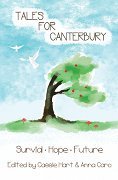 With a sudden upswing in earthquake activity over the past few days, and at least one plus 4.0 magnitude earthquake every day since Friday, it appears timely to be thinking about Tales for Canterbury again—which you may recall was put together by Cassie Hart and Anna Caro as a fundraiser for the Red Cross Christchurch Earthquake Appeal.
With a sudden upswing in earthquake activity over the past few days, and at least one plus 4.0 magnitude earthquake every day since Friday, it appears timely to be thinking about Tales for Canterbury again—which you may recall was put together by Cassie Hart and Anna Caro as a fundraiser for the Red Cross Christchurch Earthquake Appeal.
The anthology is themed around "Survival", "Hope" and "Future"—and once again, Karen Healey's The Unicorn Bell, which I loved when I read it and am sure that you will too, is from the "Hope" section of the book.
The Unicorn Bell
by Karen Healey
Nana's house was full of magic things, and the unicorn bell was the most magic of all.
Sophie liked to list the other things in groups of three, because she was seven, and Nana said seven and three were the luckiest numbers. She had to think hard about her three favourite goblets, but she decided on the biggest glass one and the smallest pewter one and the one made of battered brass, polished until it displayed her own face, glowing brown in the metal. The Sophie in the goblets had a wild smile, with sharper teeth, and the real Sophie was a little afraid of her.
The Sophie in her three favourite teaspoons was much easier to understand; the same girl, with huge eyes or enormous chin, depending how she tilted them. The magic in the teaspoons lay in the pictures of castles on the handles. The castles were called Monea and Duino and Versailles; strange names that Nana had to help Sophie say, with all the enchantment of lands across the sea.
The paintings were much less interesting, and mostly of deer or dogs or horses. Mum couldn't afford riding lessons and Sophie didn't like horses anyway. Her best friend Tracy Cho was learning how to ride, and talked importantly about manes and fetlocks and mucking out. This was a secret code, and not very fair. Still, Sophie picked her three favourite paintings. Two of them were dogs. There was a big painting of a lady in a long skirt and a blouse that buttoned all the way up her neck. She was sitting on a bench with a lot of books and leaning her chin on her hand, her forehead wrinkled like Mum's was on Thursdays. Sophie chose that as her most favourite. The lady was clearly studying spells, not Mum's accounting books, but homework was homework.
Anyway, horses were stupid.
…
To find out why The Unicorn Bell was "the most magic of all" you will have to read the full story in Tales for Canterbury. The anthology includes a range of short stories donated by both national and international authors to aid the recovery of Christchurch after the past year of earthquakes. It may be purchased from Random Static here.
—
And don't forget that tomorrow is "Fun with Thornspell" day—you can find out all about it here and read last week's feature, here.
August 22, 2011
Tuesday Poem: Guest Editor on The Tuesday Poem Hub
[image error]Today I am the guest editor on the Tuesday Poem Hub, which is the beating, driving heart of the Tuesday Poem community!
For that reason, I am not posting a poem here today, but inviting you to visit the Hub, where I have selected Rhian Gallagher's Butterfly, a contemporary villanelle, as this week's guest poem. Butterfly is included in Rhian's second collection, Shift, which is forthcoming from Auckland University Press.
But to find out more and read Butterfly, hie thee to the Tuesday Poem Hub!
And do leave a comment—I am sure it will mean a lot to Rhian, with the publication of Shift just around the corner.
To read another poem of Rhian Gallagher's, go to my Tuesday Poem post of 29 June last year, here, where I featured Rhian's poem Between, from her first collection, Salt Water Creek (Enitharmon.)
August 21, 2011
The Hugo Awards 2011 Announced
The Hugo Awards 2011 were announced at an award ceremony in Reno last night. Here's the winner of the fiction categories, for which—you may recall—I read all the shortlisted finalists.:)
Best Novel:
Blackout/All Clear by Connie Willis (Ballantine Spectra)
Best Novella:
The Lifecycle of Software Objects by Ted Chiang (Subterranean)
Best Novelette:
The Emperor of Mars by Allen M. Steele (Asimov's, June 2010)
Best Short Story:
For Want of a Nail by Mary Robinette Kowal (Asimov's, September 2010)
.
For the full results in all categories, both professional and fan, click here.
.
To read my reports on each of the 5 finalists for the award of Best Novel, click on the titles below (novels listed in alphabetical order by title):
Blackout/All Clear by Connie Willis
Cryoburn by Lois McMaster Bujold
Feed by Mira Grant
The Dervish House by Ian McDonald
The Hundred Thousand Kingdoms by NK Jemisin
.
So that's it—all over for another year! But it's been fun being part of the process, even at long distance.
August 20, 2011
A Tea Party in Amberley—Still On for September 11
On Sunday September 11 at 2.00 pm, I will be in Amberley, just north of Christchurch, as a guest of the Amberley Friends of the Library, enjoying being part of their annual Writers' Tea Party — a reading and social occasion featuring myself and my fellow writers, James Norcliffe, and Joanna Orwin.
The tea party will take place at the Hurunui Memorial Library in Amberley, an easy half hour's drive north of Christchurch. So if you're going to be in the area anyway, or fancy a spring drive to one of North Canterbury's many pretty spots—with a writer's tea party at the end of it—then this could be the event for you.
So do put it in your diary now—I would love to meet some blog readers there! 
August 19, 2011
It's—Copyedit Time!
Just a few weeks ago I was in countdown mode to get The Great Revision (TGR) of The Gathering of the Lost (The Wall of Night Book Two) done and dusted—and now it is already copyedit time! Can you believe it?
There is definitely no rest for the wicked and all I can say is that I must have been ve-ry wicked indeed in a past life! (Sadly, I haven't been at all wicked in this one …)
So here I am, in countdown mode again—and kinda hoping you will help me out like you did last time! 
Because you see, my publisher would like Gathering back by 31 August. Which I reckon is pretty durned tight for a 200,000 word, 700 page manuscript, es-special-ly since because of all that snow, the courier hasn't actually arrived with the manuscript yet!
But hey, I'm a Kiwi gal—DIY and No. 8 wire and all that jazz!—and so of course I have managed to rustle up a hardcopy ms to work off, snow or no snow. (These days, the copyeditors get to work on electronic manuscripts, but the author still has to to do her/his notations by pencil-–can you believe it?—onto a hard copy. And have you tried to find a decent pencil sharpener these days? I tell, you, gentle readers, the beast does not exist—or if it does, please send my way now, at once, today! Believe me, your name will be LEGEND.  )
)
So back to that deadline. Personally, given the size of the manuscript, I think 12 June is more realistic—but bearing in mind that whether 31st August or 12 June, this is the date the marked up hardcopy manuscript has to be back in the production department in New York. So I have to allow for courier time as well—and as I am around 10,000 miles / 14,000 kilometres and several time zones from the Big Apple, we're not talking overnight delivery: no, sirree!
So, dear readers, as aforesaid, I am now back into page and day countdown mode—and the jackpot questions. Will she do it? Or won't she? And when will she actually get it done by? Will she blow a gasket and expire in steam and smoke en route? Or will she come sailing through, all smiles and serenity? (Serenity: now there was a movie …)
Ladies and gentlemen, if there are bookies amongst you, I now invite you to take all bets—the 31st or the 12th, which will it be? For those not of a gambling disposition, well, I'm pretty sure I'll be asking you to toot again for support!
So let the games begin—or alternatively, cry havoc and loose the dogs of war! 
August 18, 2011
Six Great Non-Human Heroes of SFF: Part Two
On Wednesday, I posted the first instalment of "Six Great Non-Human Heroes of SFF", namely Creideiki from David Brin's Startide Rising, The House from Scott Westerfeld's The Risen Empire, and Iorek Byrnison from Philip Pullman's Northern Lights/The Golden Compass.
So without further ado, here's the second three of my six.
[image error]I is also for Imraith-Nimphais from Guy Gavriel Kay's Fionavar Trilogy (The Summer Tree; The Wandering Future; The Longest Road)
I don't think any consideration of non-human heroes of SFF would be complete without inclusion of a mythological creature, such as dragons (and how many of them there are—Kalessin (Earthsea), Morkeleb the Black (Dragonsbane), Ramoth (Pern), MacAvoy's Black Dragon (Tea with …), and may I say it, Balisan, in my own Thornspell); fauns (Mr Tumnus, Narnia); and unicorns, such as Jewel (again, Narnia)—and Imraith-Nimphais.
Although in fact, Imraith-Nimphais is a unicorn who can fly, so there's a nod there to the mythic pegasus as well. The totem animal of Tabor dan Ivor, one of the Dalrei of the Plains, Imraith-Nimphais is also of divine birth—a gift from the goddess Dana to answer the rise of evil in the world. Imraith-Nimphais is a creature of wild magic and in many ways a 'shining weapon', her primary purpose being to combat the creatures of evil—something she excels at doing. But she is more than that—a vivid personality in her own right and a 'weapon' who also knows how to love. At the last, Imraith-Nimphais honours that love by saving Tabor and sacrificing herself. Knowing they are vastly overmatched by an opponent (a dragon) she throws Tabor clear and flies against the dragon alone. She takes her enemy down with her though—and that, too, is in keeping with the personality of Imraith-Nimphais. In my book, her place as one of my final six is well deserved.
—
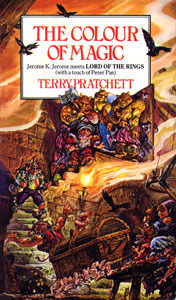 L is for The Luggage, from Terry Pratchett's The Colour of Magic and The Light Fantastic (among other Discworld novels.)
L is for The Luggage, from Terry Pratchett's The Colour of Magic and The Light Fantastic (among other Discworld novels.)
A large wooden chest (of sapient pearwood) that has little wooden legs and follows its owner around? And that can, when required, both defend itself and act as bodyguard—a very fearsome bodyguard—to its owner? No question, we have to be talking about Terry Pratchett's Luggage. Is it anthropomorphic? I would argue that it is intrinsically luggage—after all, it frequently becomes lost and must then track its owner down. Only in this case, it's also luggage combined with monster—homicidal monster, as established in Sourcery (1988)—since its response to threats is to either devour or knock a hole through them. (In the latter respect, I've always thought The Luggage was not unlike a Culture knife missile, only a lot less subtle …) Also, The Luggage can follow its master literally, well, anywhere … So, um, useful!
So when it comes to non-human heroes—using the term so loosely that perhaps I should simply stick with "protagonist" instead—there has to be a place for The Luggage.
—
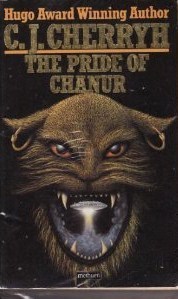 P is for Pyanfur Chanur, from CJ Cherryh's The Pride of Chanur and subsequent Chanur trilogy: Chanur's Venture, The Kif Strike Back, and Chanur's Homecoming
P is for Pyanfur Chanur, from CJ Cherryh's The Pride of Chanur and subsequent Chanur trilogy: Chanur's Venture, The Kif Strike Back, and Chanur's Homecoming
Pyanfur Chanur is a Hani, a lion-like species from the world Anuurn, where the female of the species—much like lions—take care of all the day-to day-business, including venturing into space. In many ways, the space captain Pyanfur Chanur is a renaissance figure: part merchant, part privateer, bold, swashbuckling, and tenacious. As such, she could be one of many similar Hani captains in ports throughout Compact space and along the merchanter routes—except that Pyanfur Chanur sees the big picture and knows how to play the long game. Product of a rigidly sex-role stereotyped and also xenophobic species, Pyanfur has learned to look past difference in order to survive in space; without necessarily intending to, she has become broad minded.
In many ways, Pyanfur is the classic hero figure who is forced into prominence by necessity—circumstances drive her, but in the end she turns the tables and drives them. She is also humorous, stubborn, devious, and flamboyant—but at rock bottom, honourable, and true to her allies and those she loves. In a universe of non-human heroes, you just can't go past Pyanfur Chanur.
—
So there it is, six great non-human heroes of SFF: Creideikei (Startide Rising); The House (The Risen Empire); Iorek Byrnison (Northern Lights/The Golden Compass); Imraith-Nimphais (The Fionavar Trilogy); The Luggage (The Discworld novels); and Pyanfur Chanur (The Chanur novels.)
Just a very few of a great diversity that exist in both fantasy and science fiction—so what non-human have I missed out that would be top of your list?
—
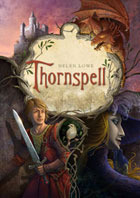 This month's "…on Anything, Really" feature is "Fun With Thornspell", running every Thursday—check out yesterday's feature here.
This month's "…on Anything, Really" feature is "Fun With Thornspell", running every Thursday—check out yesterday's feature here. 
August 17, 2011
Fun With Thornspell: Week the Third!
 Amazing to think that it is already the third week in this month's "Fun With Thornspell" feature on the blog. And there have been some great comments and character suggestions so far—I am really enjoying reading them as they come in!
Amazing to think that it is already the third week in this month's "Fun With Thornspell" feature on the blog. And there have been some great comments and character suggestions so far—I am really enjoying reading them as they come in!
For those of you who are new to this, the full info is set out here, but the basic "gen" is that if you suggest a character from Thornspell and why you like them, then at the end of the month the judges will go through the list and I will write a short story about the character they select! So keep those suggestions coming, most particularly if there's a character you haven't seen mentioned yet.
The other part of the deal though, is that each week I will talk a bit about the Thornspell story from my point of view as the author. (And by the way, feel free to make requests for topics you'd like me to cover in your comments—I will see what can be done!)
About Thornspell: The Legend of Parsifal
Last week I talked about the belvedere and this week I am going to talk about my use of the Parsifal myth in Thornspell. I have always loved the Parsifal story and wanted to work it into the backstory—in part, because I made the Thornspell world very middle-European, almost-but-not-quite Holy Roman Empire, and Parsifal is a story cycle that belongs to that part of the world. To an extent I was making the traditional Sleeping Beauty story 'new' in Thornspell—not too new though, because I like the traditional story—but I also felt that weaving my new story of the prince into the broader, European myth cycles, as well as just the fairytale, would give it greater richness and authenticity.
So that is why I decided that Sigismund's sword, Quickthorn, would be one that the dragons "made for Parsifal." (Chapter 18, pg 300)
I had already decided that Quickthorn would be "red and white"—but the amazing thing was that once I made the decision to draw on the Parsifal story, and started researching the myth cycle, there were just so many overlaps with elements in my 'new' story. For example, in one of the Parsifal variants, he has a "red sword" (which he pulls from a stone, as it happens, in much the same way as King Arthur with Excalibur.) Another overlapping aspect from the myth cycle was Parsifal's relationships with women—sometimes as a romantic interest, sometimes as mentor/guide—who could appear as either "loathly" ( I borrow the word from the Sir Gawain tale in the King Arthur cycle here) or "fair."
How apt, I thought, given I had already decided that it would be shapeshifting dragons who had mentored Parsifal—and that might well explain how a lady might appear sometimes "loathly" and sometimes "fair!" In fact some of the overlaps were so neat that I decided that the Muses, taking counsel on Parnassus, must have meant for the stories of Parsifal and Sigismund to overlap! Or—an alternative explanation—my avid reading of myths and legends as a kid had embedded the stories so deeply in my subconscious that they were just waiting for the opportunity to re-emerge in another form. (A little like those shapeshifting dragons … )
In terms of explanation, you may take your pick  —but either way, I do feel that having authentic mythological elements as backstory add to the richness of a fairytale retelling like Thornspell.
—but either way, I do feel that having authentic mythological elements as backstory add to the richness of a fairytale retelling like Thornspell.
—
Now back to the fun part—don't forget to comment and say which Thornspell character you would like a short story written about, and also why. I'm looking forward to getting some more great character suggestions to add to those from weeks one and two, which you can read here and here.
Can't find your copy or don't have time to reread and refresh your memory of the characters? You can also check out the Thornspell website and read the first chapter, here — or just click on any of the images around the web page; each one should take you to a quote about that particular character.
Have fun!

